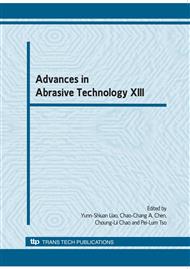p.957
p.965
p.970
p.976
p.981
p.987
p.995
p.1001
p.1007
Experimental Study on Friction Characteristics of Hot-Pressing Matrix and Granite under Dry Sliding Conditions
Abstract:
In order to understand the friction characteristics of hot-pressing bit matrix and granite under dry sliding conditions, the influence law of hardness and diamond concentration to the friction coefficient was analyzed and discussed with the data of friction coefficient and torque under different conditions. Three groups of hot-pressing matrix samples of different hardness and three groups of hot-pressing matrix samples with different diamond concentration were chosen. The friction and wear tests were carried out between hot-pressing matrix samples and granite samples. The results showed that the friction torque and coefficient firstly increased, and then decreased with the increase of hardness in dry friction experiments between granite sample and matrix sample without diamond. Compared with data from matrix sample without diamond, the friction torque and friction coefficient decreased significantly when test was carried between granite sample and impregnated diamond matrix sample. The friction torque and coefficient increased with the increase of diamond concentration.
Info:
Periodical:
Pages:
981-986
Citation:
Online since:
August 2010
Authors:
Keywords:
Price:
Сopyright:
© 2010 Trans Tech Publications Ltd. All Rights Reserved
Share:
Citation:


